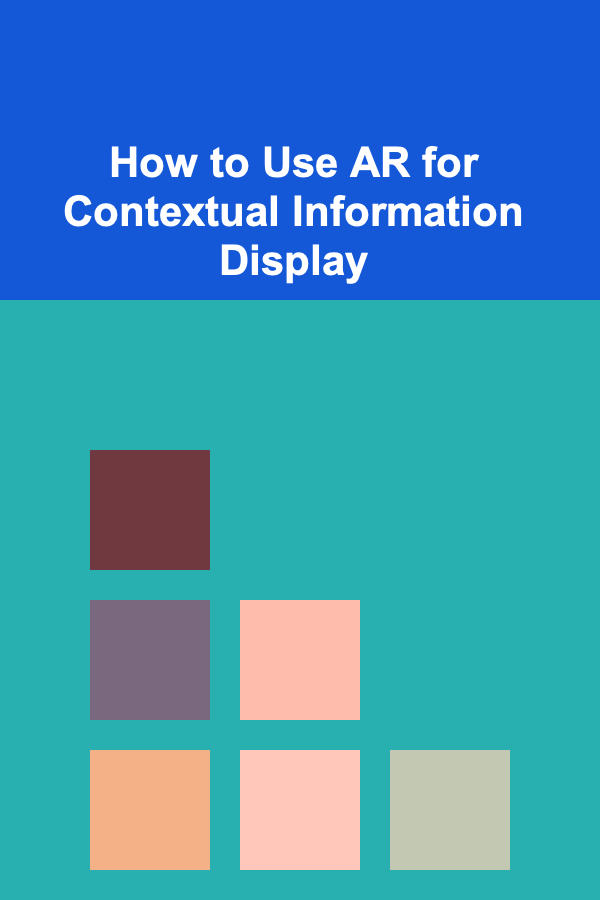
How to Use AR for Contextual Information Display
ebook include PDF & Audio bundle (Micro Guide)
$12.99$10.99
Limited Time Offer! Order within the next:

Augmented Reality (AR) is transforming how we perceive and interact with the world around us. By superimposing digital elements such as text, images, and videos onto our physical environment, AR enhances our understanding of the world and makes it easier to access contextual information. Contextual information display refers to the ability of AR systems to provide relevant data or insights based on the user's current environment or actions. Whether it's helping tourists navigate a city, assisting professionals in their work, or improving educational experiences, AR has the potential to revolutionize how we interact with information.
In this article, we will explore how AR can be used for contextual information display, the technology behind it, various applications, and its future prospects. We will also address the challenges and limitations that need to be overcome to fully realize AR's potential in this field.
Understanding Augmented Reality (AR)
What is AR?
Augmented Reality (AR) is a technology that overlays computer-generated content on top of the physical world, in real-time, typically through the use of devices like smartphones, tablets, AR glasses, and headsets. Unlike Virtual Reality (VR), which immerses the user in a completely synthetic environment, AR enhances the user's perception of the real world by adding layers of interactive content to it.
For AR to be effective, it needs to recognize and track the user's environment. This can be done using various sensors, such as cameras, GPS, accelerometers, and gyroscopes. The system then processes this information to align and anchor virtual objects in the correct location relative to the real-world environment.
Types of AR
There are several types of AR, and they can be classified based on their functionality and user interaction:
- Marker-based AR: This type of AR uses predefined markers or images that, when detected by the AR device, trigger the display of digital content. Common examples include AR experiences activated by QR codes or logos.
- Markerless AR: Also known as location-based AR, this type of AR uses sensors like GPS and accelerometers to determine the user's location and display contextual information based on it. A common example is Pokémon Go, where virtual creatures appear in real-world locations.
- Projection-based AR: This involves projecting light or images onto a surface, which can then interact with real-world objects. For instance, projection mapping used in live performances or interactive installations is a form of projection-based AR.
- Superimposition-based AR: This overlays new content onto an existing image or object, allowing the user to interact with both the physical and digital elements simultaneously. One notable example is the use of AR in medical applications, where digital scans are overlaid on the body to visualize internal organs.
The Technology Behind AR for Contextual Information Display
The success of AR in providing contextual information relies heavily on the combination of several advanced technologies. These technologies include:
1. Computer Vision
Computer vision plays a central role in AR systems, enabling devices to understand and interpret the physical world. By using cameras and sensors, AR systems can recognize objects, track their movements, and even detect environmental features like surfaces and depth. This is crucial for positioning and aligning virtual objects accurately with the real-world environment.
2. Geolocation and GPS
For AR applications that are location-based, such as navigation or tourism apps, GPS technology is essential. GPS provides the coordinates of the user's location, which the AR system then uses to determine what contextual information is most relevant. For example, a tourist app could display historical facts about landmarks as the user points their phone toward them.
3. Sensors and Motion Tracking
AR devices are equipped with various sensors, including accelerometers, gyroscopes, and magnetometers, to track the user's movements and orientation. These sensors help the system understand the user's perspective and adjust the placement of virtual content accordingly. For instance, if a user moves their phone or AR glasses, the displayed content will shift in real-time to maintain its alignment with the real world.
4. Machine Learning
Machine learning algorithms are becoming increasingly important in AR, especially in applications that require recognition and interpretation of complex objects or scenes. By training on large datasets, machine learning models can improve object recognition and adapt to dynamic environments, making the display of contextual information more accurate and responsive.
5. Cloud Computing
To handle the massive amounts of data that AR applications often require, cloud computing plays a critical role. AR systems frequently rely on cloud-based servers to store and process large datasets, such as 3D models or maps. Cloud computing enables real-time data sharing and collaboration, making it possible to deliver up-to-date contextual information that is synchronized across multiple devices.
Applications of AR for Contextual Information Display
The potential applications of AR for contextual information display are vast and span across a wide range of industries. Here are some key areas where AR is already being used effectively:
1. Tourism and Navigation
AR has made a significant impact in the tourism and navigation sectors by providing real-time contextual information about the user's surroundings. With the help of AR apps, tourists can point their smartphones at landmarks or buildings and instantly access historical information, facts, or interactive experiences.
For example, a museum could use AR to overlay additional information about artwork, artifacts, or exhibits when viewed through an AR-enabled device. This type of contextual information display not only enhances the user experience but also encourages engagement and learning.
2. Retail and Shopping
In the retail sector, AR is revolutionizing how consumers interact with products. AR apps allow customers to visualize products in their homes before making a purchase, such as trying out furniture or clothing virtually. Additionally, AR can provide contextual information about a product, such as user reviews, specifications, and pricing, all within the app.
For instance, when a customer points their smartphone at a product in-store, they may see virtual content that includes reviews or details about its features. This makes the shopping experience more informative and personalized.
3. Education and Training
AR is a powerful tool for education and training, particularly in complex or hands-on fields. By overlaying instructional content onto physical objects or environments, AR provides students with contextual information that aids learning and comprehension. For example, medical students can use AR to view 3D models of the human body and interact with them, gaining a deeper understanding of anatomy.
In technical training, AR can display step-by-step instructions for assembly, repair, or maintenance tasks. This type of contextual information display can significantly improve efficiency and reduce errors.
4. Healthcare and Medicine
In healthcare, AR is being used to provide contextual information for medical professionals. Surgeons can use AR glasses to overlay vital patient information or 3D scans of organs directly onto their field of view during surgery. This helps improve precision and decision-making, reducing the need for additional equipment or distractions during critical procedures.
Similarly, AR is being used for patient education, allowing patients to visualize medical conditions, treatments, and recovery processes in a more intuitive and interactive manner.
5. Manufacturing and Industrial Applications
In industrial settings, AR is helping workers by providing real-time, contextual information about machines, equipment, and processes. AR can display technical manuals, maintenance instructions, and real-time sensor data directly onto the user's field of view, enabling them to make quicker and more informed decisions.
In complex manufacturing environments, AR can be used to guide assembly line workers through intricate tasks, ensuring accuracy and reducing the chance of human error.
Future Prospects of AR in Contextual Information Display
The future of AR in contextual information display is incredibly promising. As technology continues to advance, several trends are expected to shape the evolution of AR:
1. Improved Hardware
With the development of lightweight, comfortable, and powerful AR glasses and headsets, AR will become more immersive and accessible. These devices will enable users to interact with contextual information without the need for handheld devices, making AR experiences more seamless and natural.
2. 5G and Edge Computing
The rollout of 5G networks and the development of edge computing will significantly improve the performance of AR applications. 5G's high-speed data transfer will enable faster rendering of AR content, while edge computing will reduce latency by processing data closer to the user, allowing for real-time contextual information display with minimal lag.
3. Advanced AI and Personalization
As AI algorithms become more sophisticated, AR will become more personalized and responsive to the user's needs. AI will be able to anticipate the information the user is most likely to need based on context, location, and preferences, delivering tailored experiences that enhance engagement and utility.
4. Collaborative AR Experiences
The future of AR will also include more collaborative experiences. Multiple users will be able to interact with the same AR content in real-time, whether for work, play, or learning. This will open up new opportunities for team-based problem-solving and interactive storytelling.
Challenges and Limitations
While AR has immense potential for contextual information display, there are several challenges and limitations that need to be addressed:
1. Accuracy and Precision
AR systems rely heavily on sensors and algorithms to align digital content with the real world. However, inaccuracies in tracking or object recognition can lead to misaligned or irrelevant contextual information. Ensuring high levels of accuracy and precision is crucial for AR to be effective.
2. Battery Life and Processing Power
AR applications are resource-intensive, requiring substantial processing power and battery life. Current mobile devices and AR glasses often struggle to support prolonged use, limiting the duration of AR experiences. Advances in battery technology and efficient processing will be necessary to overcome this challenge.
3. Privacy and Security
As AR systems collect data from users, such as location information, preferences, and interactions with the environment, privacy and security concerns arise. Developers must ensure that AR applications respect user privacy and protect sensitive information from unauthorized access.
4. User Acceptance and Comfort
Although AR technology is becoming more mainstream, widespread adoption still faces hurdles. Some users may feel uncomfortable using AR devices for extended periods, especially if they require wearing glasses or headsets. Creating lightweight, comfortable, and intuitive AR experiences will be crucial for encouraging broader adoption.
Conclusion
Augmented Reality has the potential to change how we interact with information in the world around us. By providing contextual information based on real-time data, AR enhances our understanding of our environment and empowers us with relevant insights. From tourism and education to healthcare and retail, AR is already revolutionizing industries and improving user experiences.
As the technology advances and new innovations are developed, the possibilities for AR in contextual information display are limitless. By overcoming the challenges of accuracy, hardware limitations, and user comfort, AR will continue to evolve and become an indispensable tool for personal, professional, and educational purposes.
The future of AR is bright, and with continued investment in research and development, we can expect even more immersive, intelligent, and useful AR applications that will transform the way we interact with the world around us.

How to Create a Checklist for Seamless Customer Onboarding
Read More
How to Market Your Rental Property During Off-Season
Read More
How to Reflect on Your Home's Seasonal Needs
Read More
How to Store and Organize Kids' Toys in Small Living Spaces
Read More
How to Use Throw Pillows and Blankets for Style and Comfort
Read More
Mastering Public Relations: Essential Strategies for the Modern Public Relations Specialist
Read MoreOther Products

How to Create a Checklist for Seamless Customer Onboarding
Read More
How to Market Your Rental Property During Off-Season
Read More
How to Reflect on Your Home's Seasonal Needs
Read More
How to Store and Organize Kids' Toys in Small Living Spaces
Read More
How to Use Throw Pillows and Blankets for Style and Comfort
Read More